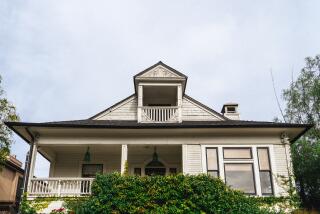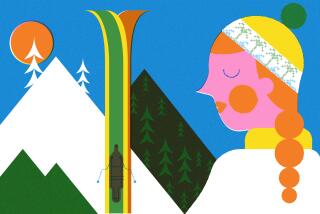Skiing Comfortably in the Alps
WENGERNALP, Switzerland — When choosing a mountain hotel in Switzerland, first I want some charm. Then I must have comfort. I hate to shoulder my skis at the end of a glorious day on the slopes to trudge blocks in ski boots, so I favor hotels that you can glide back to, just stepping out of your skis at the front door. That narrows your choices considerably.
High on my list is the Jungfrau Hotel in Wengernalp. One tiny railway stop and the hotel. Nothing else. When the last train departs for Wengen at 7 p.m., when the last ski patroller in his orange parka flashes by to close the piste , there is nothing but snow, the tracks and the impressive rock wall of the Eiger, the Monch and the Jungfrau.
The 40-bed hotel is among the few old-time mountain hotels, way above a resort, that have become a skier’s delight: spotless rooms that get a fresh coat of paint each spring, lacy quilt covers, waxed pine floors carpeted in blue, rustic painted chests and wardrobes, copper pans filled with plants or Erica von Almen’s dried flower arrangements.
In the wood-paneled main room, a carrot cake is set out for tea by the fire. At the bar, a guide maps out the next day’s excursion. In the kitchen, chef Peter Otto puts the finishing touches on dinner.
‘Alpine and Proud’
On the landing, 19th-Century prints record the growth of the hotel from a cowherd’s barn to today’s cozy hideout.
Wengernalp is on a high Oberland passage that Lord Byron once rode feeling “Alpine and proud.” In the steps of the poet came the “romantic tourists,” then Thomas Cook’s first tours.
The first hotel was built in 1865, a severe wooden cube faced with shingles. Later came the railway, the Victorians and finally the skiers. Each winter the Lauberhorn World Cup skiers pass what is still called Byron’s Hill.
“We inherited the place in ‘62,” said Kaspar von Almen, a third-generation hotelier. “Every year we have done something--enlarged the main room and terrace, put in bathrooms, converted rooms in the attic. We plan a sauna next. But we don’t intend to get any bigger. We can just manage nicely in winter.”
Running a hotel at 1,870 meters (about 6,155 feet) is complex. Everything must be stocked ahead in the vast cellars or brought in by train daily. Milk, bread and croissants come up from Wengen, fresh vegetables and meat from Interlaken.
“Twice a week our fishmonger meets a flight in Geneva to pick up seafood,” Von Almen said, explaining how the hotel gets lobster to serve.
Despite the difficulties, all the young Von Almens have been trained to take over. Katrin will replace her mother; Christian, his father. Andreas, an architect, supervises the remodeling, but in time he will manage his aunt Heidi’s hotel at Kleine Scheidegg, a turn-of-the-century palace at the foot of the Eiger, the base for mountain climbers’ attempts on its North Wall.
Both hotels are for sports lovers who can skip discos to step out of the hotel and into their skis, for those who want to catch the first chairlift to the Lauberhorn’s untracked snow, then work their way around Alpine terrain baptized long ago--by young British skiers or interned airmen--with names such as Punchbowl, Bumps, Mac’s Leap, the Rat Run or, simply, Oh God.
World’s Highest Railway
Eighty kilometers of runs connect to car-free Wengen and the cable car to the Mannlichen or over Kleine Scheidegg to the Eigergletscher station or the easy blue run to Grindelwald.
Non-skiers can ride by train through the same scenery or up the world’s highest railway to the Jungfrau glacier. Skibob, a local invention, is another way to get around in an area where even the postman makes his rounds on a wooden ski bike.
For skiers and non-skiers alike, a grand hotel on the slopes, the Schatzalp, on a shelf 300 meters above Davos, is closer to the boutiques, bars, hockey matches and concerts of the busy snow city.
Before laying the first stone, the owner had to build a cog railway to bring up construction materials and the furnishings expected by the clientele: stained-glass windows, crystal chandeliers, Oriental rugs, a collection of Baedekers, hundreds of rattan chaise lounges.
The funicular yo-yos to town in four minutes. A sled run takes you down even faster, while skiers prefer to be whisked by gondola up to Strela Pass for the connection to Parsenn.
The Schatzalp is out of an Ingmar Bergman movie: Wide endless corridors lead to salons, dining rooms and reading rooms.
Schatzalp, like most palace hotels, was geared to the elaborate taste of English dukes or Russian archdukes.
The idea of turning the Alps into a winter playground dates back to 1866 and is usually blamed on a bet by hotel keeper Johannes Badrutt II with some Englishmen that they would find sun in St. Moritz in January or he wouldn’t charge them a centime.
Later, Cesar Ritz, who came from a Swiss valley so snow-locked that everyone is called Ritz, worked up from busboy and learned the ways so well that the name now stands for grand hotels. Hotel schools refined his great hotel formula by adding the economies of hotel management to the essentials of service.
Over the years, Swiss hotels have grown to many sizes and many tastes. Those who like their hotels on the slopes consider the supreme versions to be St. Moritz’s Suvretta House.
Suvretta House offers a private ski lift to Piz Nair, plus an ice rink, a pool and a bus shuttle to St. Moritz’s jewelry auctions or bobsled taxi rides. Recently, a floor of the hotel was converted into Club Suvretta to attract a more casual, younger crowd who no longer want to dress for dinner.
Patrician Mansion
Swiss friends recommend the comfortable Hotel Margna in Sils-Baselgia--a patrician mansion turned long ago into a summer hotel but recently opened in winter, too, for its site on the edge of the frozen lake at the start of the annual Engadine ski marathon. This area is mainly for cross-country but also has ski bus connections to downhill runs on Furtschellas and Corvatsch.
On the other hand, some hotels don’t pretend to offer anything but simple meals and a convivial atmosphere. The Weisshorn, built in 1882 at 2,500 meters above the Valaisan village of Chandolin, is a bring-your-own-sleeping-bag, no-frills affair for determined skiers and hikers who reach it in winter by snowcat.
There are flat trails to cross-country skiing behind the hotel, while downhill skiers must warm up by climbing a small hill before reaching the ski runs.
A snowcat picks them up at the end of the day. “We have a list of our skiers and have never forgotten any,” says Anne-Madeleine Staub, who with her husband, Jean-Jacques, has already added heating to half of the old hotel and hopes some day to make it more comfortable. “Baths are a problem; we have to bring up all our water with the snowcat.”
Without going that far, a young Swiss hotelier is trying another formula. The Hotel Guarda Val at Lenzerheide/Sporz puts its guests into eight converted barns into which the cows were taken each May to pasture on the new grass.
Thick plaster, old beams, exotic wallpapers give the rooms an individual touch. Once the cows heated the sleeping quarters above their stalls. Fortunately, Reto Cottiati learned his basics in Lausanne’s Ecole Hotelliere and the revamped rooms have radiators with thermostats, bathrooms and minibars.
Minimum prices per person with half-board range from 40 Swiss francs (about $56 U.S.) for the Hotel Weisshorn in Chandolin to 110 francs at the Hotel Jungfrau in Wengernalp and 165 francs at the Suvretta House in St. Moritz.
For further information contact Swiss National Tourist Office, 250 Stockton St., San Francisco 94108.
More to Read
Sign up for The Wild
We’ll help you find the best places to hike, bike and run, as well as the perfect silent spots for meditation and yoga.
You may occasionally receive promotional content from the Los Angeles Times.






